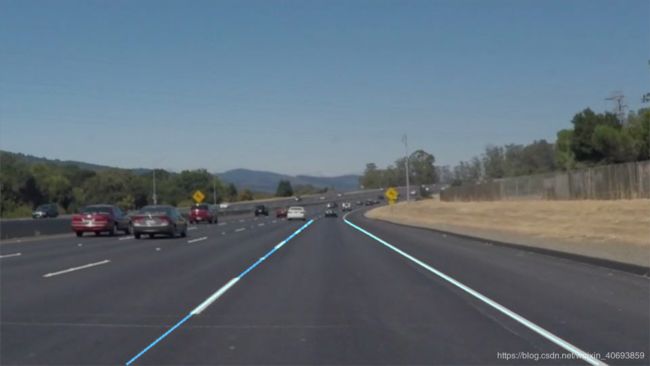Python+OpenCV实现车道线检测代码部分
实验时 使用的是python3.7+cv2,直接在Anaconda上面直接安装,代码在Jupyter上跑的,图片是老师给的(—.—)
经过各个滤波后,划定区域 :
最终合成的图像 :
最后实际上是先把篮框框内的两条线截出来,之后使用最小二乘拟合出两条直线,然后将其与原图合并,形成车道线的检测,当时写这个实验参考了许多CSDN上,简书上,知乎上以及Github的一些开源代码,这个实验知识应用了最基础的图像滤波实现一些检测,之后的多传感器数据融合之类的更高级的分析,就要参考一些更专业的文章了。
import matplotlib.pyplot as plt
import matplotlib.image as mpimg
import numpy as np
import cv2
%matplotlib inline
image = cv2.imread('1.jpg',0)
print('This image is:', type(image), 'with dimensions:', image.shape)
import math
def grayscale(img):
"""
将图像处理为灰度图像,因为使用cv2read所以要用BGR进行转换
"""
return cv2.cvtColor(img, cv2.COLOR_BGR2GRAY)
def canny(img, low_threshold, high_threshold):#返回image,边缘部分为255,其余为0
return cv2.Canny(img, low_threshold, high_threshold)
def gaussian_blur(img, kernel_size):
return cv2.GaussianBlur(img, (kernel_size, kernel_size), 0)
def region_of_interest(img, vertices):
mask = np.zeros_like(img)
print("mask_shape",mask.shape)
if len(img.shape) > 2:
channel_count = img.shape[2] # i.e. 3 or 4 depending on your image
ignore_mask_color = (255,) * channel_count
else:
ignore_mask_color = 255
cv2.fillPoly(mask, vertices, ignore_mask_color)
masked_image = cv2.bitwise_and(img, mask)
return masked_image
def draw_lines(img, lines, color=[255,116,10], thickness=2):
left_lines_x = []
left_lines_y = []
right_lines_x = []
right_lines_y = []
line_y_max = 0
line_y_min = 999
for line in lines:
for x1,y1,x2,y2 in line:
if y1 > line_y_max:
line_y_max = y1
if y2 > line_y_max:
line_y_max = y2
if y1 < line_y_min:
line_y_min = y1
if y2 < line_y_min:
line_y_min = y2
k = (y2 - y1)/(x2 - x1)
if k < -0.3:
left_lines_x.append(x1)
left_lines_y.append(y1)
left_lines_x.append(x2)
left_lines_y.append(y2)
elif k > 0.3:
right_lines_x.append(x1)
right_lines_y.append(y1)
right_lines_x.append(x2)
right_lines_y.append(y2)
#最小二乘直线拟合
left_line_k, left_line_b = np.polyfit(left_lines_x, left_lines_y, 1)
right_line_k, right_line_b = np.polyfit(right_lines_x, right_lines_y, 1)
#根据直线方程和最大、最小的y值反算对应的x
cv2.line(img,(int((line_y_max - left_line_b)/left_line_k), line_y_max),(int((line_y_min - left_line_b)/left_line_k), line_y_min),color, thickness)
cv2.line(img,(int((line_y_max - right_line_b)/right_line_k), line_y_max),(int((line_y_min - right_line_b)/right_line_k), line_y_min),color, thickness)
def hough_lines(img, rho, theta, threshold, min_line_len, max_line_gap):
lines = cv2.HoughLinesP(img, rho, theta, threshold, np.array([]), minLineLength=min_line_len, maxLineGap=max_line_gap)
print(lines.shape)
line_img = np.zeros((img.shape[0], img.shape[1], 3), dtype=np.uint8)
draw_lines(line_img, lines)
return line_img
def weighted_img(img, initial_img, α=0.8, β=1., γ=0.):
return cv2.addWeighted(initial_img, α, img, β, γ)
ini_image = cv2.imread("1.jpg")
#plt.imshow(ini_image)
imshape=ini_image.shape
gray=grayscale(ini_image)
#after灰度处理
kernel_size=5
blur=gaussian_blur(gray, kernel_size)
#after高斯模糊
low_threshold=50
high_threshold=200
edges=canny(blur, low_threshold, high_threshold)
vertices=np.array([[(0,imshape[0]),(imshape[1]/2-20, imshape[0]/2+50),
(imshape[1]/2+20, imshape[0]/2+50),
(imshape[1],imshape[0]),(0,500),(960,500)]],
dtype=np.int32)
partial=region_of_interest(edges,vertices)
x=[0,0,460,500,960,960]
y=[540,500,320,320,500,540]
plt.plot(x,y)
plt.imshow(edges)
rho=1
theta=np.pi/180
threshold=13
min_line_len=15
max_line_gap=10
lines=hough_lines(partial, rho, theta, threshold, min_line_len, max_line_gap)
final=weighted_img(lines,ini_image)
ini_image = cv2.imread("1.jpg")
imshape=ini_image.shape
gray=grayscale(ini_image)
#after灰度处理
kernel_size=5
blur=gaussian_blur(gray, kernel_size)
#after高斯模糊
low_threshold=120
high_threshold=200
edges=canny(blur, low_threshold, high_threshold)
#aftercannoy滤波
vertices=np.array([[(0,imshape[0]),(imshape[1]/2-20, imshape[0]/2+50), \
(imshape[1]/2+20, imshape[0]/2+50), (imshape[1],imshape[0]),(0,500),(960,500)]], \
dtype=np.int32)
partial=region_of_interest(edges,vertices)
rho=1
theta=np.pi/180
threshold=13
min_line_len=15
max_line_gap=10
lines=hough_lines(partial, rho, theta, threshold, min_line_len, max_line_gap)
final=weighted_img(lines,ini_image)
cv2.imshow('Final', final)
cv2.waitKey(0)
cv2.destroyAllWindows()

